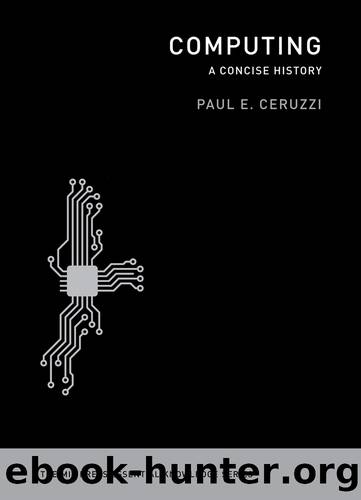Computing by Ceruzzi Paul E

Author:Ceruzzi, Paul E. [Ceruzzi, Paul]
Language: eng
Format: epub
ISBN: 9780262310390
Publisher: MIT Press
Published: 2012-08-14T16:00:00+00:00
Figure 5.1
Patent for the microprocessor.
The Personal Computer
Second only to the airplane, the microprocessor was the greatest invention of the twentieth century. Like all other great inventions, it was disruptive as much as beneficial. The benefits of having all the functionality of a general-purpose computer on a small and rugged chip are well known. But not everyone saw it that way. The first, surprisingly, was Intel, where the microprocessor was invented. Intel marketed the invention to industrial customers and did not imagine that anyone would want to use it to build a computer for personal use. The company recognized that selling this device required a lot more assistance than was required for simpler devices. It designed development systems, which consisted of the microprocessor, some read-only and read-write memory chips, a power supply, some switches or a keypad to input numbers into the memory, and a few other circuits. It sold these kits to potential customers, hoping that they would use the kits to design embedded systems (say, for a process controller for a chemical or pharmaceutical plant), and then place large orders to Intel for subsequent chips. These development kits were in effect genuine computers and a few recognized that, but they were not marketed as such.
Hobbyists, ham radio operators, and others who were only marginally connected to the semiconductor industry thought otherwise. A few experimental kits were described in electronics hobby magazines, including 73 (for ham radio operators) and Radio Electronics. Ed Roberts, the head of an Albuquerque, New Mexico, supplier of electronics for amateur rocket enthusiasts, went a step further: he designed a computer that replicated the size and shape, and had nearly the same functionality, as one of the most popular minicomputers of the day, the Data General Nova, at a fraction of the cost. When Micro Instrumentation and Telemetry Systems (MITS) announced its “Altair” kit on the cover of the January 1975 issue of Popular Electronics, the floodgates opened (see figure 5.2).
Download
This site does not store any files on its server. We only index and link to content provided by other sites. Please contact the content providers to delete copyright contents if any and email us, we'll remove relevant links or contents immediately.
Algorithms of the Intelligent Web by Haralambos Marmanis;Dmitry Babenko(16280)
Jquery UI in Action : Master the concepts Of Jquery UI: A Step By Step Approach by ANMOL GOYAL(9408)
Test-Driven Development with Java by Alan Mellor(7738)
Data Augmentation with Python by Duc Haba(7614)
Principles of Data Fabric by Sonia Mezzetta(7383)
Learn Blender Simulations the Right Way by Stephen Pearson(7296)
Microservices with Spring Boot 3 and Spring Cloud by Magnus Larsson(7142)
Hadoop in Practice by Alex Holmes(6589)
RPA Solution Architect's Handbook by Sachin Sahgal(6519)
The Infinite Retina by Robert Scoble Irena Cronin(6220)
Big Data Analysis with Python by Ivan Marin(5938)
Life 3.0: Being Human in the Age of Artificial Intelligence by Tegmark Max(5520)
Pretrain Vision and Large Language Models in Python by Emily Webber(4897)
Infrastructure as Code for Beginners by Russ McKendrick(4658)
Functional Programming in JavaScript by Mantyla Dan(4441)
WordPress Plugin Development Cookbook by Yannick Lefebvre(4388)
The Age of Surveillance Capitalism by Shoshana Zuboff(4253)
Embracing Microservices Design by Ovais Mehboob Ahmed Khan Nabil Siddiqui and Timothy Oleson(4149)
Applied Machine Learning for Healthcare and Life Sciences Using AWS by Ujjwal Ratan(4137)
